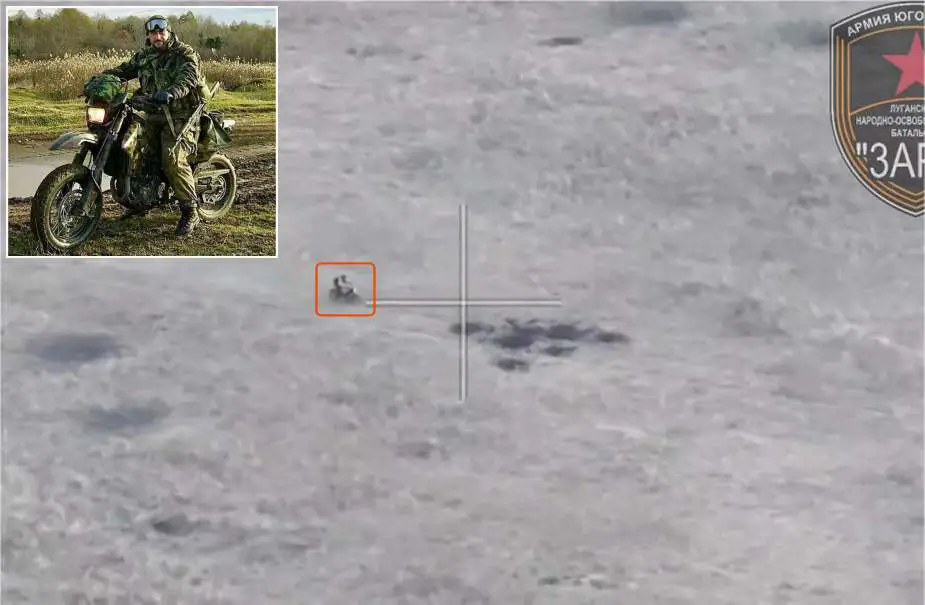Russian battalion attacks Ukrainian positions on off-road motorcycles
On April 10, 2024, reports emerged on Russian social media detailing an operation by the Russian Zarya battalion against Ukrainian positions, where off-road motorcycles were utilized for the assault. This operation was captured in published footage that highlighted the battalion's rapid movement towards enemy defenses after artillery preparation. The tactic employed, which focused on speed and maneuverability, allowed the assault groups to approach their target without detection until they were close, leading to the successful capture of a Ukrainian stronghold.
Follow Army Recognition on Google News at this link

The adoption of such tactics by the Zarya battalion appears to be a probable response to the increasing utilization of unmanned aerial vehicles (UAVs) by Ukrainian forces. (Picture source: Russian social media)
The adoption of such tactics by the Zarya battalion appears to be a probable response to the increasing utilization of unmanned aerial vehicles (UAVs) by Ukrainian forces, primarily for surveillance and direct attacks. The use of motorcycles in this operation suggests a potential shift in the strategy of the Russian Army's smaller units towards a greater emphasis on mobility and the element of surprise.
Russian military reporter Alexander Sladkov and military expert Andrei Klintsevich have commented on this new tactic within several Russian media. Sladkov noted the usefulness of motorcycles in combat situations without providing specific plans, while Klintsevich discussed the tactical benefits of motorcycles and ATVs in navigating difficult terrains. For them, this could indicate a broader trend to counteract the increased use of drones by adversaries, emphasizing dispersal and movement speed to complicate targeting by Ukrainian UAVs.
Specifically, the decision to employ motorcycles and ATVs in operations by Russian units, as demonstrated by the Zarya battalion, seems to be a reaction to the challenges posed by enhanced drone capabilities of the Ukrainian Armed Forces. With Ukrainian forces expanding their drone operations, the vulnerability of ground units to aerial surveillance and targeting has become more pronounced, as reported several times by the Army Recognition editorial team. The strategy of utilizing smaller, highly mobile assault groups is aimed at reducing this vulnerability, making it more challenging for drones to effectively track and engage them.
From a military point of view, the choice of off-road vehicles like ATVs and motorcycles for such operations offers tactical advantages, including enhanced maneuverability and speed across various terrains. This facilitates rapid and stealthy approaches to enemy positions, reducing the time exposed to detection and hostile engagement.
Moreover, the increasing use of UAVs by Ukrainian forces for surveillance and precision strikes could have led to a reassessment of movement and assault tactics by Russian units. Adapting tactics for increased mobility and reduced visibility aims to mitigate the technological advantages held by Ukrainian forces. Smaller units on motorcycles and ATVs present a smaller visual profile compared to more traditional military assets such as tanks and trucks, rendering them more difficult to detect, track, and target from the air. The tactical environment in Ukraine, characterized by effective drone surveillance and the use of kamikaze drones, presents significant challenges to Russian military operations, including the difficulty of massing forces without detection before assaulting a Ukrainian position.
Furthermore, motorcycles offer the capability to navigate difficult terrains more effectively, providing new approaches to targets and enabling rapid redeployment or withdrawal as necessary. Compared to heavier military vehicles, motorcycles and ATVs are also relatively low-cost and easier to maintain, allowing for their deployment in greater numbers with less support infrastructure. This logistical aspect underlines a shift towards more dynamic operational tactics in response to the conditions on the battlefield.























